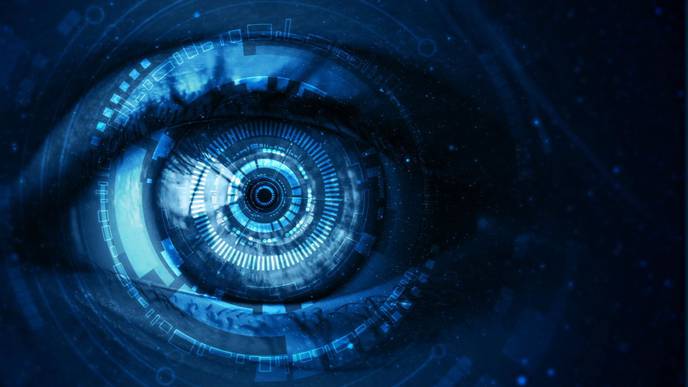AI Eye Test Detects Brain Injuries in Minutes

12/19/2023
University of Birmingham researchers have created a device that diagnoses brain injuries by scanning eyes. They named the gadget EyeD, which uses AI to match eye patterns with those experiencing brain injuries. Unlike conventional methods, it is lightweight, portable, and easy to use so that first responders can check and treat injuries immediately.
We have many ways of scanning the brain for injuries, but most are bulky and take a long time to provide analyses. That delay might allow the damage to worsen and spread, endangering a person’s life. Consequently, this AI eye test could become a vital tool in saving lives.
This article will discuss how the AI eye test functions. Later, I will share other artificial intelligence innovations in healthcare.
How does the AI eye test work?
Interesting Engineering says the EyeD is a “handheld tool that combines a smartphone, a laser, and a spectrometer to measure the molecular changes in the eye linked to brain damage.” It shines a safe laser on the back of a patient’s eye.
The AI eye test captures light reflected by the tissue. The reflected light contains information about the chemical composition of the eye. For example, it conveys the levels of lipids and proteins, which are the biomarkers of brain injury.
Next, the device uses a smartphone camera and a spectrometer to analyze the light. EyeD feeds the data into a neural network program to classify cases as brain injury or non-brain injury.
Its features are possible because the eye connects to the brain via the optic nerve. Also, the neuroretina is behind it, which is similar to brain tissue. That means brain injuries can affect the eye and vice-versa.
The University of Birmingham researchers know brain injury can have serious and lasting impacts if not treated as soon as possible. However, it’s difficult to spot symptoms immediately after an accident.
Often, the diagnoses require sophisticated imaging techniques like MRI and CT scans, which are only available in hospitals. However, brains only have an hour before an injury seriously damages it, called the “golden hour.”
You may also like: Why AI is the latest game-changer for sports
Waiting for a diagnosis may lead patients to waste that golden hour. Fortunately, the AI eye test is compact enough for first responders to carry to an emergency.
They could shine the device into an injured person’s eye to determine whether they have brain damage. Then, they may administer proper first aid before paramedics arrive.
However, the researchers admit the device is still a proof-of-concept. They want to test the device’s performance on human subjects further.
Other AI health projects
Scientists have also been merging healthcare and artificial intelligence in other ways. For example, another AI eye test from the British Journal of Opthalmology checks cardiovascular risks in seconds.
The Journal developed an AI algorithm called QUARTZ (QUantitative Analysis of Retinal vessels Topology and siZe) to check heart health via eye scans.
It uses a database of retinal images from 88,052 UK Biobank participants and 7,411 people from a European Prospective Investigation into Cancer (EPIC)-Norfolk study.
QUARTZ compares a patient’s eye scans to these photos so that it can diagnose potential issues. For example, if your eye scan is similar to a stroke patient, it would say you have a high risk for it.
Also, the health tech company LabGenius created an artificial intelligence that facilitates antibody creation. Antibodies are immune system proteins that attach to bacteria, viruses, and other antigens.
Pharmaceutical companies have been creating synthetic antibodies since the 1980s. They help treat diseases like cancer and help a recipient’s body accept a transplanted organ.
You may also like: ChatGPT diagnosis detects disease after 17 doctors failed
However, it is a slow process requiring protein designers to sift through millions of potential combinations of amino acids. “If you want to create a new therapeutic antibody, somewhere in this infinite space of potential molecules sits the molecule you want to find,” says LabGenius founder and CEO James Field.
Wired said the medical firm created a machine-learning model to produce an antibody quickly from millions of possible combinations. Consequently, it made antibody development faster and easier than humans doing it manually.
“The only input you give the system as a human is, here’s an example of a healthy cell, here’s an example of a diseased cell,” the CEO said. “And then you let the system explore the different [antibody] designs that can differentiate between them.”
Conclusion
University of Birmingham scientists have created an artificial intelligence that analyzes eyes to detect brain injuries. The best part is you can carry it anywhere, unlike CT and MRI scan machines.
That means first responders can carry these devices to diagnose the injured quickly. Then, they could administer the proper first aid and save a person’s life.
Learn more about the AI eye test by reading its ScienceAdvances webpage. Moreover, check out the latest digital tips and trends at Inquirer Tech.
TOPICS:

Facebook Comments